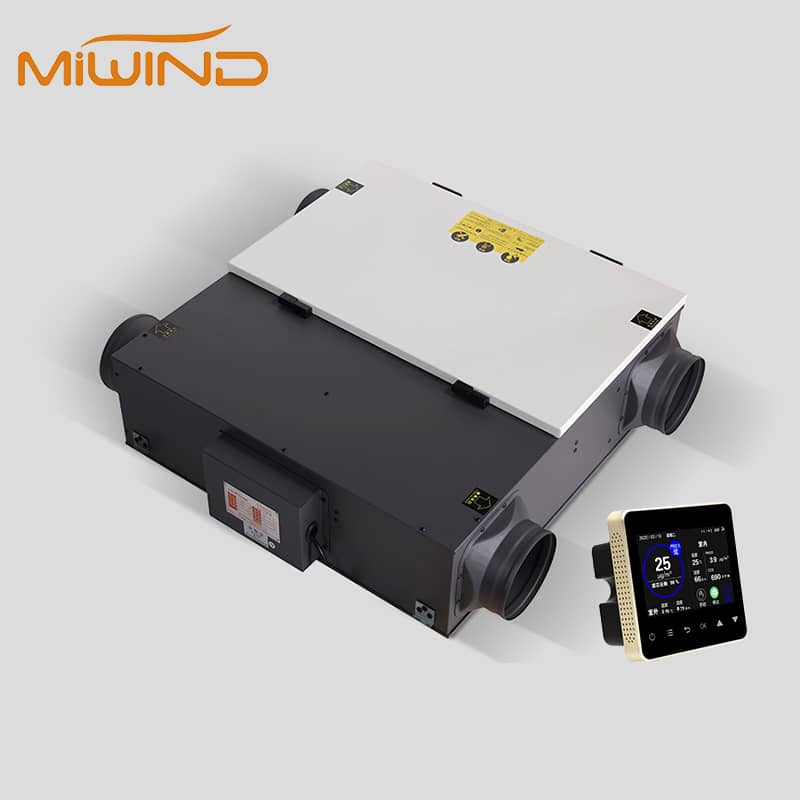
Heat recovery ventilation (HRV) systems and heat recovery exhaust fans are advanced heat exchange ventilation fans designed to improve indoor air quality and reduce energy loss. Unlike traditional exhaust systems that simply remove stale air, an exhaust air heat recovery system captures the heat from outgoing indoor air and reuses it to pre-condition incoming fresh air.
At the core of an HRV system lies the heat recovery fan, equipped with a high-efficiency heat exchanger that transfers thermal energy between two air streams without mixing them. This explains how a heat recovery ventilation fan works, ensuring stale air leaves the building while fresh air enters with minimal energy loss.
In colder seasons, the HRV exhaust fan channels warm indoor air through the heat exchange ventilation chamber, allowing recovered heat to warm incoming fresh air. In summer, the heat flow reverses, reducing cooling loads.
Moreover, advanced HRV systems often incorporate filtration mechanisms that further enhance indoor air quality. These filters can remove particulate matter, allergens, and other airborne contaminants from the incoming air, creating a healthier and more breathable indoor environment. Some systems even include activated carbon filters to remove odors and volatile organic compounds (VOCs).
While the fundamental principle remains the same, Heat Recovery Ventilation systems come in various forms, each tailored to specific environmental conditions and building requirements.
Heat Recovery Ventilators (HRV): These systems focus on sensible heat transfer and are ideal for climates with large temperature differences. Key benefits of HRV systems include improved air quality, reduced heating demand, and prevention of indoor dryness in winter.
Energy Recovery Ventilators (ERV): ERVs, on the other hand, transfer both sensible heat and latent heat (moisture). This makes them particularly effective in humid climates, where controlling indoor humidity levels is crucial for preventing mold growth and maintaining comfort.
The selection of an appropriate HRV system hinges on a comprehensive understanding of the local climate, the building's construction characteristics, and the specific indoor air quality goals.
The advantages of installing Heat Recovery Ventilation Exhaust Fans extend far beyond mere comfort and convenience. They represent a tangible investment in energy efficiency, indoor air quality, and long-term sustainability.
Enhanced Indoor Air Quality: HRV systems continuously replenish stale indoor air with fresh, filtered outdoor air, removing pollutants, allergens, and odors. This results in a healthier living and working environment, particularly beneficial for individuals with respiratory sensitivities or allergies. The constant air exchange reduces the concentration of airborne contaminants, mitigating the risk of respiratory ailments and improving overall well-being.
Substantial Energy Savings: A major advantage in the heat recovery ventilation system pros category is its ability to recover up to 70–95% of heat from outgoing air, dramatically reducing heating and cooling costs.
Precise Moisture Control: HRVs and ERVs help regulate indoor humidity levels, preventing condensation, mold growth, and other moisture-related problems. By effectively managing moisture, these systems contribute to the longevity of building materials and minimize the risk of structural damage. ERVs, in particular, excel at maintaining optimal humidity levels, preventing excessively dry or humid conditions that can lead to discomfort and health issues.
Balanced Ventilation: Unlike traditional exhaust fans that can create negative pressure within a building, HRVs provide balanced ventilation, ensuring a consistent supply of fresh air without compromising energy efficiency. This balanced approach eliminates the need for supplemental ventilation methods, such as trickle vents or window openings, which can introduce drafts and compromise thermal comfort.
Mitigation of Odors and Pollutants: HRV systems effectively remove indoor air pollutants, including VOCs, odors, and other contaminants, creating a healthier and more pleasant indoor environment. This is particularly important in buildings where occupants spend a significant amount of time indoors, such as offices, schools, and hospitals.
Reduction of Carbon Footprint: By lowering energy consumption, HRV systems contribute to a smaller carbon footprint, aligning with sustainability goals and promoting environmental responsibility. The reduced reliance on fossil fuels for heating and cooling translates into a direct reduction in greenhouse gas emissions, helping to combat climate change.
The successful implementation of Heat Recovery Ventilation Exhaust Fans requires careful planning and consideration of various factors.
System Sizing: It is crucial to select an HRV system that is properly sized for the building's square footage and occupancy levels. An undersized system will not provide adequate ventilation, while an oversized system may lead to energy waste.
Ductwork Design: The ductwork must be meticulously designed to ensure optimal airflow and minimize pressure drops. Improperly designed ductwork can reduce the efficiency of the HRV system and compromise its performance.
Professional Installation: Installation should be performed by qualified HVAC professionals to ensure proper setup and functionality. Professional installers have the expertise to ensure that the HRV system is properly integrated with the building's existing HVAC system and that all components are functioning correctly.
Maintenance: Regular maintenance, including filter replacement and system inspections, is essential for maintaining optimal performance and extending the lifespan of the HRV system.
In conclusion, heat recovery ventilation systems, HRV exhaust fans, and heat exchange ventilation fans provide an energy-efficient way to improve air quality. Understanding what a heat recovery fan is, how it works, and the main pros and cons helps homeowners and businesses choose the right exhaust air heat recovery system for long-term comfort and sustainability.